
Longships were a type of specialised Viking warships that have a long history in Scandinavia, with their existence being archaeologically proven and documented from at least the fourth century BC. Originally invented and used by the Norsemen for commerce, exploration, and warfare during the Viking Age, many of the longship's characteristics were adopted by other cultures, like Anglo-Saxons, and continued to influence shipbuilding for centuries. The longship's design evolved over many centuries, and continuing up until the 6th century with clinker-built ships like Nydam and Kvalsund. The longship appeared in its complete form between the 9th and 13th centuries. The character and appearance of these ships have been reflected in Scandinavian boat-building traditions until today. The particular skills and methods employed in making longships are still used worldwide, often with modern adaptations. They were all made out of wood, with cloth sails and had numerous details and carvings on the hull.

The River Waveney is a river which forms the boundary between Suffolk and Norfolk, England, for much of its length within The Broads.

Viking ships were marine vessels of unique structure, built by the Vikings during the Viking Age.

HMS Battler (D18) was an Attacker-class escort aircraft carrier that served with the Royal Navy during the Second World War.
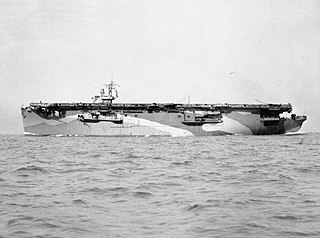
USS Block Island (CVE-8) was an Attacker-class escort aircraft carrier that served during World War II.

USS Breton (CVE-10) was a Bogue-class escort carrier that served during World War II as the British Attacker-class escort carrier HMS Chaser (D32).

HMS Fencer (D64) was an Attacker-class escort aircraft carrier that served with the Royal Navy during the Second World War.

The USS Hamlin (CVE-15) was one of a large group of escort aircraft carriers built on Maritime Commission C-3 hulls and transferred to the Royal Navy under lend-lease during World War II. Launched by Western Pipe and Steel Company, San Francisco, California, 5 March 1942, as AVG-15, aircraft escort vessel, she was sponsored by Mrs. William H. Shea. Her designation was changed to ACV-15, auxiliary aircraft carrier, 20 August 1942, and she was acquired and simultaneously transferred to the United Kingdom 21 December 1942. Hamlin's designation was changed to CVE-15, escort aircraft carrier, 15 July 1943.

USS St. George (CVE-17) was laid down on 31 July 1941 as a C3-S-A2 by Ingalls Shipbuilding, Hull 296 of Pascagoula, Mississippi, under Maritime Commission contract as the (second) SS Mormacland for Moore-McCormack Lines, Inc.,. She was renamed St. George (AVG-17) by the United States Navy on 7 January 1942; and assigned to the United Kingdom under Lend-Lease as HMS Pursuer on 24 February 1942.

The name Prince William (CVE-19) was assigned to MC hull 198, a converted C3 laid down by the Western Pipe and Steel Company, San Francisco, California, 15 December 1941.
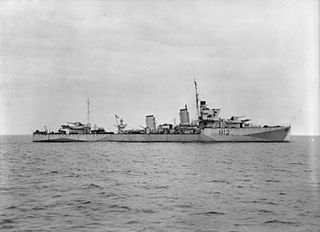
The A- and B-class destroyers were a group of 18 destroyers built for the Royal Navy during the late 1920s, with two additional ships built for the Royal Canadian Navy. The British ships were divided into two flotillas of eight destroyers, each with a flotilla leader.

The Town class was a group of twenty-one light cruisers built for the Royal Navy (RN) and Royal Australian Navy (RAN). These vessels were long-range cruisers, suitable for patrolling the vast expanse covered by the British Empire. These ships, initially rated as second class cruisers, were built to a series of designs, known as the Bristol, Weymouth, Chatham, Birmingham and Birkenhead classes – all having the names of British towns except for the RAN ships, which were named after Australian cities.

The Oseberg ship is a well-preserved Viking ship discovered in a large burial mound at the Oseberg farm near Tønsberg in Vestfold county, Norway. This ship is commonly acknowledged to be among the finer artifacts to have survived from the Viking Era. The ship and some of its contents are displayed at the Viking Ship Museum at Bygdøy on the western side of Oslo, Norway.

Marco Polo was a three-masted wooden clipper ship, launched in 1851 at Saint John, New Brunswick. She was named after Venetian traveler Marco Polo. The ship carried emigrants and passengers to Australia and was the first vessel to make the round trip from Liverpool in under six months. Later in her career, the ship was used as a cargo ship before running aground off Cavendish, Prince Edward Island in 1883.
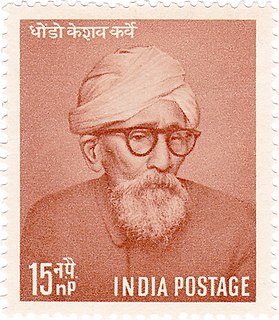
Dhondo Keshav Karve, popularly known as Maharshi Karve, was a social reformer in India in the field of women's welfare. In his honour, Queen's Road in Mumbai (Bombay) was renamed to Maharshi Karve Road. Karve was a pioneer in promoting widows' education. The Government of India awarded him with the highest civilian award, the Bharat Ratna, in 1958, the year of his 100th birthday.
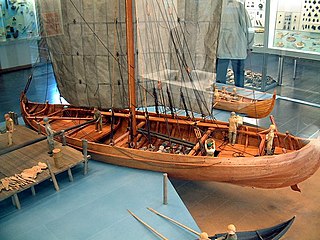
A knarr is a type of Norse merchant ship used by the Vikings. The knarr was constructed using the same clinker-built method as longships, karves, and faerings.
Brooke Marine was a Lowestoft-based shipbuilding firm. The company constructed boats and small ships for civilian and commercial use, as well as minor warships for the Royal Navy, Royal Navy of Oman, Royal Australian Navy, Kenya Navy and United States Navy.
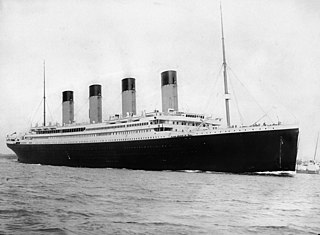
RMS Titanic was a British passenger liner operated by the White Star Line that sank in the North Atlantic Ocean in the early morning hours of 15 April 1912, after striking an iceberg during her maiden voyage from Southampton to New York City. Of the estimated 2,224 passengers and crew aboard, more than 1,500 died, making the sinking one of modern history's deadliest peacetime commercial marine disasters. RMS Titanic was the largest ship afloat at the time she entered service and was the second of three Olympic-class ocean liners operated by the White Star Line. She was built by the Harland and Wolff shipyard in Belfast. Thomas Andrews, chief naval architect of the shipyard at the time, died in the disaster.

Maud, along with Albion, is one of only two surviving Norfolk trading wherries to be found on the Norfolk Broads. Maud was built in 1899, and served as a sailing wherry and later as a lighter before being sunk in the mid-1960s as protection for part of the banks of Ranworth Broad. In 1981, she was refloated and taken to Upton where she was restored over a number of years, finally returning to the water in 1999. As of 2010, Maud is active on the Norfolk Broads. She is listed on the register of National Historic Ships in the United Kingdom, as part of the National Historic Fleet.

Hathor (1905) is one of only six surviving Norfolk pleasure wherries to be found on the Norfolk Broads. Like two of the other surviving wherries, Maud and Solace, she was built by D. S. Halls of Reedham. Hathor has been listed on the register of National Historic Ships in the United Kingdom since 1996 and is part of the National Historic Fleet.



















